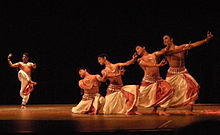Indisk dans

Indisk dans omfattar fleire ulike danseformer, som klassisk indisk dans, ei rekkje folkedansar og nyare koreograferte dansar. Mange lokale tradisjonar bygde på støtte frå rike fyrstar, og har gjerne ein forteljande funksjon der dei kan formidla ulike mytar, som soger frå Ramayana eller Mahabharata.[1] I indisk film finn ein ofte store dansenummer som kan vera koreograferte med element frå desse formene. Gjennom den vide utbreiinga til indiske filmar, særleg Bollywood-filmar, er slik dans blitt kjend verda over.
Historie[endre | endre wikiteksten]

Kulturelt sett har dans ein viktig plass i det indiske samfunnet. Dans kan vera eit religiøst uttrykk, og fleire gudar blir omtalte som dansarar. Allereie i Rigveda er Indra nemnd som ein dansar. I seinare hinduisme er Sjiva kalla Nataradja, 'kongen av dans'. Sanskritteksten Natyasjastra[2] og religiøse tradisjonar innan hinduismen dannar grunnlaget for det ein reknar som dei klassiske dansane.[3][4][5]
Det finst dokumentasjon på dans i India frå førhistorisk tid. Steinaldermåleri som ved verdsarvstaden Bhimbetka i Madhya Pradesh syner dansescenar.[6] Skulpturar frå Induskulturen, med funnstader i noverande India og Pakistan, viser også dansandefigurar. Til dømes syner den kjende Dansande jente-skulpturen frå rundt 2500 f.Kr. ei jente ståande i noko som gjerne blir tolka som ein dansepositur.[7][8][9]
Nokre ulike dansar[endre | endre wikiteksten]

- Sjå òg klassisk indisk dans
- Singhajit Singh
- Rouff frå Kashmir
- Hikat frå Himachal Pradesh
- Dalkhai frå Orissa
- Gendi av gondfolket i Madhya Pradesh.
- Britadans frå Bengal
- Kali natsj
- Bihu frå Assam
Galleri[endre | endre wikiteksten]
-
-
Skulejenter i Uttarakhand syng og dansar.
Kjelder[endre | endre wikiteksten]
- ↑ McCormick, Charlie T.; White, Kim Kennedy (13. desember 2010). Folklore: An Encyclopedia of Beliefs, Customs, Tales, Music, and Art. ABC-CLIO. s. 705. ISBN 978-1-59884-241-8.
- ↑ James G. Lochtefeld (2002). The Illustrated Encyclopedia of Hinduism: N-Z. The Rosen Publishing Group. s. 467. ISBN 978-0-8239-3180-4., Quote: "the Natyashastra remains the ultimate authority for any dance form that claims to be 'classical' dance, rather than 'folk' dance".
- ↑ Julius Lipner (2012). Hindus: Their Religious Beliefs and Practices. Routledge. s. 206. ISBN 978-1-135-24061-5. «It would be appropriate here to comment on Hindu classical dance. This developed in a religious context and was given high profile as part of temple worship. There are a number of regional and other styles as well as source texts, but the point we wish to stress is the participative nature of such dance. In form and content, the heart of dance as worship in Hinduism has always been 'expression' (abhinaya), i.e. the enacting of various themes.»
- ↑ Jean Holm; John Bowker (1994). Worship. Bloomsbury Academic. s. 85. ISBN 978-1-85567-111-9.. Sitat: Hindu classical dance-forms, like Hindu music, are associated with worship. References to dance and music are found in the vedic literature, (...)".
- ↑ Frank Burch Brown (2013). The Oxford Handbook of Religion and the Arts. Oxford University Press. s. 195–196. ISBN 978-0-19-972103-0.. Sitat: All of the dances considered to be part of the Indian classical canon (Bharata Natyam, Chhau, Kathak, Kathakali, Kuchipudi, Manipuri, Mohiniattam, Odissi, Sattriya and Yakshagana) trace their roots to religious practices (...) the Indian diaspora has led to the translocation of Hindu dances to Europe, North America and to the world."
- ↑ Kapila Vatsyayan (1982). Dance in Indian Painting. Abhinav Publications. s. 12–19. ISBN 978-81-7017-153-9.
- ↑ «Collections:Pre-History & Archaeology». National Museum, New Delhi. Arkivert frå originalen 6. januar 2019. Henta 30. desember 2017.
- ↑ Upinder Singh (2008). A History of Ancient and Early Medieval India: From the Stone Age to the 12th Century. Pearson Education. s. 153–162. ISBN 978-81-317-1120-0.
- ↑ Gregory L. Possehl (2002). The Indus Civilization: A Contemporary Perspective. Rowman. s. 111–115 with Figures 6.4–6.5. ISBN 978-0-7591-0172-2.
- Denne artikkelen bygger på «Indisk dans» frå Wikipedia på svensk, den 4. april 2011.
